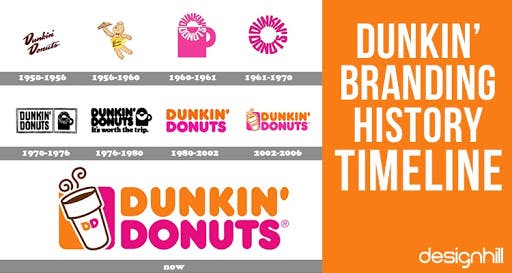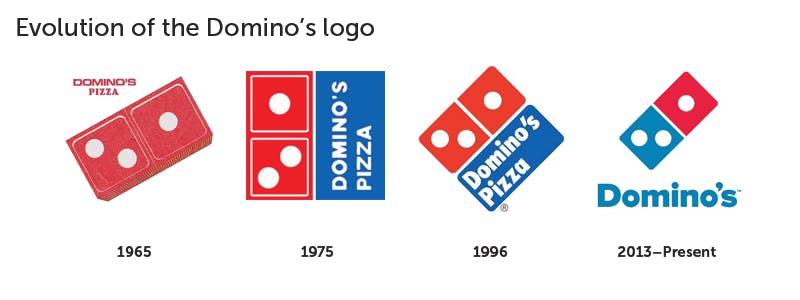Efficient rebranding: strategy, process & examples
May 24th, 2021

Contents
What is rebranding?
Rebranding strategy
Rebranding process
Examples of great rebranding
Rebranding checklist
Many successful brands, including startups and Fortune 500 companies like Microsoft, Pepsi, or American Airlines, evolve over time by changing their images, positioning, and visual identity. Rebranding is a sign that the company sets new objectives and tries to achieve greater heights. It is the opportunity to target a broader audience and strengthen the brand’s presence in the market. Rebranding helps the company keep up with the competition when it faces new technological shifts or the emergence of the latest industry trends. It is also often a necessary step for the companies which expand to the international markets or launch new product lines. So how do you know that your business needs to rebrand? And if you indeed need to, how to do it smoothly so that you benefit from it rather than receiving pushback and discouragement from your loyal customer base? Read on to learn the ins and out of efficient rebranding.
What is rebranding?
Rebranding is a marketing strategy aimed at developing the new identity of the established brand in the minds of consumers, investors, and competitors by creating a new name, symbol, visual identity, positioning, or combination of the elements. The main objective of rebranding is to change the customers’ perception of the product or service by modernizing the brand and adapting it to the customers’ needs and tastes.
Successful rebranding usually requires more effort than making several changes to the logo or promotional materials. It strives to design the improved strategy to support the brand’s core message while connecting with the audience in a new and authentic way. Rebranding often affects not only external perceptions but the internal practices of the company. Due to this reason, the process of rebranding often involves different departments, marketing, sales, and customer service teams usually being the ones changing the most.
Reasons for rebranding (and not rebranding)
Rebranding is a time- and cost-consuming procedure, and it often entails some risks. Even when you are not planning to change the brand’s entire concept, your company will face some significant transformations. So it is crucial to assess the need for rebranding and choose the right moment when it fits into your overall business strategy. Here is the list of the reasons why rebranding is necessary for your business.
Better competitive differentiation. When the brands are establishing the market presence, they often use generic templates to make a logo. Generic branding often creates problems as it is challenging to achieve a competitive advantage when the brands look the same. Rebranding allows for telling a more powerful brand story and demonstrating your benefits to the target audience.
The need for up-to-date brand identity. Design and technology trends are developing at a fast pace. The outdated identity can decrease your sales and prevent growth. In order not to lag behind, it is essential to monitor the emerging tendencies and adapt your brand to the changing environment.
The necessity to outgrow the negative reputation. If your brand had issues, which created long-term reputational damage, the rebrand could help your consumers see your business in a new light and change their perspective. In this case, your brand recognition would not decrease, but you will be able to turn negative brand perception into a positive or a neutral one.
Expanding into new markets. One more reason for rebranding is targeting new markets and developing new product offerings. When your business evolves and changes over the years, you need to rebrand and provide the opportunity for new customers and prospects to connect with your brand.
In some cases, rebranding is NOT a good idea, so you need to look for other solutions. We will list the reasons when you should not rebrand below.
Sales decline. When sales go down, the business owners often consider rebranding to revitalize the company and become relevant to the clients again. However, declining sales can result from many reasons like the lack of employee training or economic recession. Thus, before rushing into an immediate rebrand, it is better to analyze the financial reports and determine the potential reasons for the decrease in sales.
Unwillingness to update the visual assets. Rebranding implies not just changing the company’s logo, so if you are not ready to modernize the other company’s visual assets, you might not achieve your objectives.
A desire for change. Some executives believe that it’s one of the marketing’s best practices to rebrand every few years to stay on your customers’ radars. But this is far from true - once you rebrand, you need to invest your marketing efforts into making sure that your loyal customers know your new brand and can find you whenever they purchased from you previously. And that’s the time and money you’re taking away from expanding your customer base. On the other hand, many well-known brands like Coca-Cola maintain the consistency of their brand image for many years, which makes their brand stronger and helps them stay one of the most valuable brands in the world for several decades in a row.
Rebranding strategy
Rebranding can redesign the entire brand identity or make minor changes to the existing image of the brand. Identifying the reason for the rebrand will help choose the most suitable rebranding strategy. There are two major types of rebranding strategies: complete rebrand and brand refresh. Let’s start with a simpler one.
Brand refresh
The partial rebrand is effective for well-established businesses when there is a need to retain brand loyalty while refreshing the identity, services, or marketplace. The purpose for brand refresh is the addition of new products or the need to turn the outdated image of the brand into more contemporary. If you do not want to eliminate the brand’s value established over the years, you can make subtle changes to update the brand. For example, you can make a new logo design or apply a new color palette. The partial rebrand is also the opportunity to test the waters and experiment with the latest ideas before going for the complete rebrand.
Complete rebrand
A complete or total rebrand is required when your company needs to reimagine the overall brand identity and perception on the market. The reasons for a complete rebrand often include the merger between two companies, new company’s objectives, or a shift in focus. A business considers the complete rebrand when the company needs to position itself in the new direction. Complete rebrand often implies all-encompassing transformation, including the new messaging, imagery, and change of the name. This approach might be helpful when the company wants to improve the reputation by erasing the previous identity and replacing it with new messaging and imagery.
Rebranding process
Once you understand which strategy would be more efficient for your company — brand refresh or a complete rebrand, it is time to turn the plan into action following several simple steps.
1. Research target audience and market
Conduct market research and estimate whether the current brand image fits the customers’ wants and needs. Analyze direct competitors on the market. Create buyer personas to understand whether you want to focus on existing customers or expand to the new target audience. You can use focus groups and surveys to gather customers’ opinions on your brand’s existing products, story, and reputation. The information will help you establish your actual market and audience and understand the characteristics of your intended target customers.
2. Re-evaluate your vision and mission
There are several key elements of your brand which you need to refine during the rebranding process. When the company grows and evolves, it reaches its goals and objectives, and they change over time. Once you decide to undergo the rebranding process, you need to revise your vision and mission statements to reflect the new company’s culture.
Vision. Vision is one of the essential aspects of the company’s strategy because it states the current and future objectives of the organization. If the vision has changed over time, it is critical to ensure that your company’s employees have a firm understanding of the goal in order to keep everyone on the same page. Within the rebranding, the vision would affect every aspect of the rebrand, starting from the logo redesign and ending with the new employee training process.
Mission. The mission statement defines the purpose the company serves to the customers and society in general. Mission also plays the role of the internal purpose, informing the employees as to who you are and what your company stands for. If you redefine the mission, it may affect every aspect of your communication, from the audiences you connect with to the messages and the tone of voice you use.
Values. The company’s values serve as the cultural cornerstones, fundamental principles, and beliefs that guide all company’s actions. When the company grows and evolves, its values naturally change with time. So if your brand can no longer support the old values, you need to make the necessary updates to reflect the actual underlying philosophies that lead your business and its employees.
Brand voice. As the other aspects of your business are changing, your brand voice should also face some necessary transformation. The tone, vocabulary, and voice of the brand should correlate with the message. If you are changing the essence of your message, you need to modify the form as well.
3. Change the name of the company
Changing the company’s name is often a risky venture as you can lose recognition and organic search traffic. If the company’s name aligns with your new brand’s vision, mission, and values, the best decision would be to leave it unchanged. But if the current name does not correspond to the brand identity, there are several ways to mitigate the risks arising from the rebranding process. For example, you can use an old word in a new way, modify the spelling, add a prefix or suffix, translate it to other languages or create an acronym.
4. Update the key messages
A good slogan should reflect the company’s vision and mission and resonate with the consumers. It should be catchy and contain the company’s purpose. Changing the slogan is more manageable than changing the name in terms of marketing efforts. However, you need to carefully evaluate the necessity of this change. Customers might love the old slogan, so it is crucial to involve the focus groups to figure it out. The best practices for creating slogans include making a claim, using metaphors and poetic language, providing instructions, and complimenting clients.
5. Redesign your brand identity
The next step of the rebranding process involves redesigning your brand identity elements such as logo, color palette, typography, and imagery.
Logo. The logo is one of the most memorable components of your brand, along with the name. So, you can try to maintain the elements of the old logo to support a sense of continuity and brand recognition. A great logo should be simple, adaptable, and at the same time, it should make an impact. In addition, a perfect logo should correlate with your brand’s vision, mission, and values in the long run.
Color palette. Changing the color palette can seriously affect the success of the rebranding process as the colors are often related to customers’ associations with certain brands. The most valuable tools for modernizing the color palette of your brand are competitor analysis and color psychology. The latter will help you better understand how to reflect the desired brand image by choosing the appropriate colors.
Typography. Perception of the brand is not only conveying its personality but also building the experience. Some elements can hurt the customers’ experience of your brand and evoke unpleasant emotions. That is why it is important to choose the typography with readable and understandable fonts that can be easily adapted for various electronic and printed materials.
Create a brand book. A brand book is a document that contains the brand’s core values, mission, vision, and brand identity guidelines for internal and external communications. The brand book allows to organize brand information and maintain the consistency of the visual concept. The brand book should include a brand name, brand story outline, visual guidelines, such as logo and its variations, color scheme, icons, typography and images reflecting the brand personality, communication guidelines with the tone of voice, style, and language used in emails, social media, and other platforms.
Review the updated brand changes internally and with focus groups. Rebranding might deter loyal customers, so it is important to conduct intensive research involving the focus groups. There would always be people resistant to changes. However, the goal is to get approval from the majority of customers before the launch of the refreshed brand.
6. Prepare and conduct the launch
This is the final stage of the rebrand that implies releasing the improved brand to the world. You need to prepare a solid strategy that will address both internal and external aspects of the public launch of the rebrand.
Attain new trademarks. To avoid legal problems, it is essential to consult the trademark attorney before the trademark registration. The issues may arise when the brand does not fall under the criteria of a trademark because it is generic or too descriptive. You also need to take into account other legal considerations, such as intellectual property protection.
Purchase new URLs. There are few things to consider when choosing the new domain names for your brand. The brand name should be concise and easy for a user to type in a search box. Try to avoid using hyphens or numbers. If you are a local company, you can use the geographic keywords in the brand name.
Create new social media handles to smoothly transition once you rebrand. Check the handle availability across various social media. If the handle is already taken, create the variations for different platforms you are going to use. Social media handles should be consistent for all the platforms because it contributes to better brand recognition and improves communication. The best way to achieve consistency is to avoid using punctuation, such as underscores and periods. The perfect handle should be short, easy to spell and pronounce and remain relevant in the future.
Communicate internally among the employees. You need to notify your employees and stakeholders about the rebrand before the official announcement. Prepare the communication plan with release dates, formal letters, social media posts, and email announcements. Create the presentation with the reasons for rebranding, necessary changes, and the positive results you expect from these activities.
Update or redesign the website. A great business website with good UI/UX, well-prepared descriptions, and high-quality images has better chances to influence your customers’ buying decisions. While updating your website, consider the information you are going to add on your homepage, the channels used by the visitors to come to your website, and the ways in which users would be able to find the site. Analyze the competitors’ websites and find good and bad examples that would serve as relevant reference materials.
Prepare an external launch campaign. A perfect way to announce the rebranding to your customers is to prepare engaging activities like contests, charity events, or sales. This will help to keep the consumers involved and demonstrate the benefits of the rebrand. One of the most effective tools to announce your rebrand is social media. You can write social media posts or launch ads about your rebranding efforts.
Consider making a separate campaign to clearly communicate the rebrand. Rebranding is more than a new name or logo. This is an entirely new vision with refreshed vision, mission, and goals that should be clearly outlined to your employees and customers across various channels. The communication should be transparent to inform people about the reasons for change and the possible outcomes for the company. The major elements of the successful rebranding campaign include the audience and competitor research, solid reasoning to support the rebrand, consistency across platforms, and a realistic timeline.
Taking a look at the following cases will be worthwhile to get some insights into excellent rebranding. Consider them as the best practices for your future rebranding campaign.
Examples of great rebranding
We will consider the examples of successful rebranding from the world’s most recognized companies.
Dunkin Donuts rebranding
Dunkin Donuts is one of the largest coffee chains in the world. Despite the fact the company operates in more than 35 countries and has over 11,000 locations, the brand is still not immune to the competition. Dunkin Donuts’ competitors include Krispy Kreme, Einstein Bros, Starbucks, Peet's Coffee & Tea, and others.

In 2018, the company decided to undertake efforts and reestablish the dominance in the market, attract new customers and increase sales. The brand’s objective was not only to change the name, logo, and other visual assets. The company also upgraded the interior and exterior of its stores by investing $100 million. Dunkin Donuts also shortened the name to Dunkin’ and changed the typography. As a result, over the past three years, the company doubled the stock price in the New York Stock Exchange. In comparison, Starbucks increased the stock price only by 20% during the same period.
Alaska Airlines rebranding
The merger of Alaska Airlines and Virgin Airlines in 2016 became the reason for the rebrand as the target audience, and the company’s offering expanded. It was the first major brand change in 25 years.

Alaska Airlines updated the icon, wordmark, and color palette. To create a new fresh look for the brand, the company collaborated with a global branding and design firm Hornall Anderson. The design team spent a year in partnership with Alaska to develop the new visual assets for the company. The new design emphasized the personality and values of the brand, so Alaska Airlines rebranding is now considered one of the most influential rebrands of 2016.
Old Spice rebranding
Old Spice has been a recognized men’s grooming brand since 1938. By 2000, the brand was associated with the older demographics, making it challenging to reach an audience younger than 50. Old Spice decided to undergo a complete rebrand to attract a younger customer base, especially the Millenials.
One of the main Old Spice competitors was Dove Men+Care. The brand needed a campaign that would have encouraged the younger audience to buy Old Spice instead of Dove Men+Care. The other objective of the rebrand was to increase the company’s market share.

Old Spice upgrade was one of the most successful rebrands of the decade. The company featured new commercials, redesigned the site, and changed the packaging. Old Spice created the marketing campaign and involved Isaiah Mustafa to gain the attention of the younger audience. The slogan of the campaign was: “Smell like a man, man”. The brand managed to reposition itself on the market, becoming associated with confident young men while retaining its heritage and authenticity.
Domino’s rebranding
Today Domino’s is the largest pizza chain with a stock price of $432 compared to less than $10 at the beginning of 2010. One of the company’s main success ingredients was the rebrand done by the CEO Patrick Doyle and his team. His idea of rebranding campaign was to offer technology, such as pizza tracker and mobile application, and tell the story of change admitting the company’s faults.

The rebranding affected the technology, the ordering process, and the way the company managed its operations. Then the company launched an advertising campaign where the focus groups shared their complaints about the quality of the pizza. The company’s CEO appeared in the ads, acknowledged the criticism, and promised to improve the recipes. Besides the products and technology, the company changed the brand’s visual assets, such as the logo and design of the delivery cars.
Rebranding checklist
The process of rebranding is often fraught with difficulties. It might be risky, costly, and daunting. However, if done correctly, the rebrand can completely transform your company, attract new clients, bring more revenue and breathe new life into your brand. It is essential to track the success of the rebrand by communicating with target customers, monitoring the comments on social media, and checking the brand mentions online, and engaging external marketing consultants if you require additional expertise. The rebranding checklist will help you to make sure you did not miss anything.
- Start with defining your brand mission, values, vision, and purpose.
- Develop a rebranding strategy that aligns with your existing brand.
- Analyze the competitors and conduct market research.
- Estimate the rebranding budget. Include the costs for promoting and developing your new brand.
- Set the timelines needed for the brand overhaul.
- Think about how to communicate the changes to your internal team.
- Plan the visual aspects of your brand.
- Update your website.
- Improve the marketing channels.
- Launch your rebrand and announce it to the world.
The rebrand is not the end of the story; it is just the beginning. Further, you will need to maintain the consistency of your brand across the marketing channels, promote the new identity and develop the newly created brand personality. Your efforts might be met with criticism, but future success is worth it.
